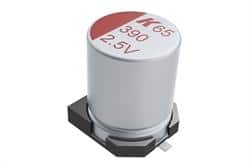source: Kemet news
MUNICH, GERMANY–(Marketwired – November 08, 2016) – KEMET Corporation (NYSE: KEM), a leading global supplier of electronic components, announced six new families of surface mount and through-hole conductive polymer aluminum solid electrolytic capacitors, with voltage ratings up to 250 VDC. Leveraging KEMET’s latest high-conductivity polymer, the new devices have very low equivalent series resistance (ESR) resulting in low self-heating and high ripple-current capability.
The high ripple current capability allows these new devices to replace arrays of multiple conventional electrolytic capacitors connected in parallel, thereby enabling designers to save PCB real estate. In addition, the new families deliver enhanced reliability by giving ten-times longer life for every 20°C reduction in operating temperature. Conventional capacitors give only double the lifetime for every 10°C reduction, according to conventional guidelines.
The through-hole devices cover capacitance values from 2.2 to 1,500 microfarads, in four families that give designers a choice of properties including 2.5-250 VDC operating voltage range, extended lifetime of up to 5,000 hours, and -55°C to 125°C specified-temperature range.
The surface-mount families feature operating voltage up to 50 VDC, specified-temperature range of -55°C to 105°C, rated lifetime of 2,000 hours, and capacitance values between 10 and 2,700 microfarads.
































